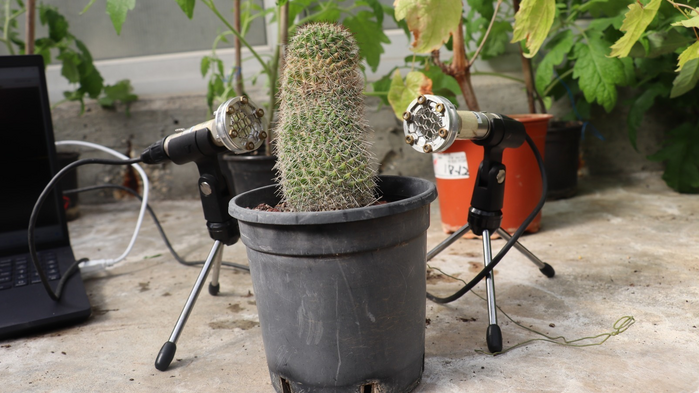According to a new study researchers are describing as a global breakthrough, plants are not as silent as we once thought.
They do make sounds, particularly when injured or stressed — just not ones that we can hear with our ears.
Researchers at Tel Aviv University recorded and analyzed sounds emitted by plants and discovered that they give off clicking sounds, emanating at a volume similar to human speech, but too high for our ears to pick it up.
“Apparently, an idyllic field of flowers can be a rather noisy place,” Lilach Hadany, a professor from the School of Plant Sciences and Food Security at the Wise Faculty of Life Sciences, said in a press release. “It's just that we can't hear the sounds!"
Generally, researchers observed that plants made significantly more sounds when under stress, and that the sound varied by plant and by the type of stress they were experiencing.
This means that not only are plants making sounds, but those sounds contain information that animals and other plants may be able to understand.
This isn’t the first time scientists have investigated whether or not plants make sound, but recording and analyzing it is a first, researchers say.
"From previous studies we know that vibrometers attached to plants record vibrations. But do these vibrations also become airborne soundwaves - namely sounds that can be recorded from a distance?” Hadany said. “Our study addressed this question, which researchers have been debating for many years.”
TALKING TO PLANTS
In order to isolate the plants and ensure that any sound picked up by recording equipment could only be coming from the plants and not the atmosphere around them, researchers placed plants in an acoustic box in an environment with no background noise.
They used recording equipment capable of picking up frequencies between 20 and 250 kilohertz, reaching more than 15 times higher than the maximum frequency the average adult can hear.
The plant types utilized in this study included wheat, corn, cactus and henbit, with most of the research focusing on tomato and tobacco plants.
"Before placing the plants in the acoustic box we subjected them to various treatments: some plants had not been watered for five days, in some the stem had been cut, and some were untouched,” Hadany said. “Our intention was to test whether the plants emit sounds, and whether these sounds are affected in any way by the plant's condition.”
In general, the plants emitted sounds within the 40-80 kilohertz range, meaning they were giving off ultrasonic sounds. Plants having a good day were generally quieter, emitting less than one sound per hour on average.
But plants which were dehydrated or injured would let out dozens of sounds every hour, according to researchers.
These sounds would be loud enough to be heard by any creature within three to five metres that could hear within the proper frequency.
In a video posted by Tel Aviv University in conjunction with the study, researcher Yehuda Anikster played a recording of sounds emitted by tomato plants and by grape vines, both of which had been manipulated by researchers to play at a frequency human ears could pick them up. The tomato plants created heavier, thicker sounding clicks, while the recording of the grape vines had lighter, shorter clicking noises.
The differences in recordings were distinct enough that it was possible to tell the type of plant and the type of stress it was experiencing just by listening to the sound, researchers found.
SOUND INCREASES AS STRESS DOES
After researchers had recorded the isolated sounds from the plants, they rerecorded them in a greenhouse setting, surrounded by other plants and sounds, and found that they were still able to recognize the distinct sounds from the plants.
In the greenhouse setting, they also recorded a group of tomato plants as they grew increasingly dehydrated, and found that their sound outpoint increased steadily for the following four to five days after being watered, and then decreased.
Essentially, the thirstier the plants got, the louder they complained — until they reached a certain critical stage of dehydration, at which point their voices quieted as they dried up.
"In this study we resolved a very old scientific controversy: we proved that plants do emit sounds!” Hadany said. “Our findings suggest that the world around us is full of plant sounds, and that these sounds contain information – for example about water scarcity or injury.”
Because many animals, such as bats and rodents, are capable of hearing much higher frequencies than we are, researchers guessed that these animals have probably known about the symphony of forests and plants much longer than we have.
Likely animals have learned how to interpret the information communicated by the sounds plants make, researchers said, and it’s possible that other plants are also gleaning information from these sounds.
“We believe that humans can also utilize this information, given the right tools - such as sensors that tell growers when plants need watering,” Hadany said.
So how are the plants actually making these sounds? That’s something researchers still don’t know. They theorized that changing pressures within the stem of the plants could be creating the actual noise, with different stem sizes corresponding to the different frequencies observed between plant types, but it’s something that will need to be researched further.








































